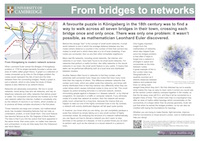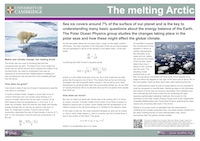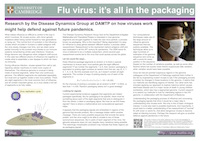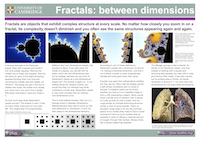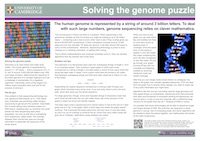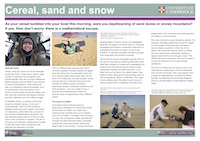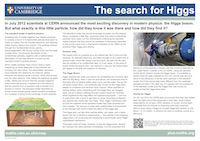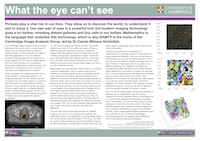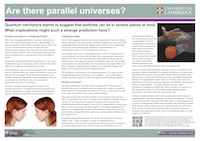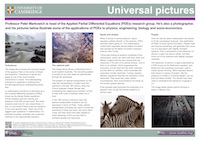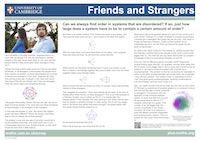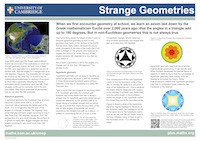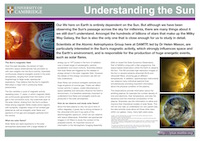Maths for your wall!

Over the years Plus has created a number of posters, designed for display in classrooms, libraries and science festivals to enthuse and inspire students and readers and promote particular areas of Plus content. The posters listed below are designed to provide brief versions of Plus articles produced with researchers from the University of Cambridge, perfect for science festivals, open days and maths fairs. As well as these, you can find more posters to download here.
Note on copyright and permissions
We are happy for you to print out copies of the Plus posters for your own non-commercial use, at home or in a classroom, or at events such as maths fairs or university open days, but we retain copyright on all the posters, and you may not modify them in any way.
Note that all the posters are between 1 and 5 MB in size
From bridges to networks – How a cute 18th century puzzle laid the foundations for one of the most modern areas of maths: network theory. This poster is based on various Plus articles on networks and graph theory.
The melting Arctic – The Arctic ice cap is melting fast and the consequences are grim. Mathematical modelling is key to predicting how much longer the ice will be around and assessing the impact of an ice free Arctic on the rest of the planet. This poster is based on an interview with Professor Peter Wadhams from the Polar Ocean Physics Group.
Flu virus: it's all in the packaging – Why is the flu virus so dangerous? This poster, based on an article by Julia Gog, head of the Disease Dynamics Research Group, explains that the unusual structure of the influenza genome can lead to dangerous evolutionary jumps, and how mathematics is helping to understand how the virus replicates.
Fractals: between dimensions – No matter how closely you zoom in on a fractal it never smooths out, you see the same complexity at every scale and often the same structure appearing again and again. This poster is based on various Plus articles on fractals.
Solving the genome puzzle – The human genome is represented by a sequence of 3 billion As, Cs, Gs, and Ts. With such large numbers, sequencing the entire genome of a complex organism can only be solved with clever algorithms. This poster is based on an interview with Gos Micklem, Director of the Computational Biology Institute.
Cereal, sand and snow – All of these are examples of granular flows. This poster is based on our interviews with Nathalie Vriend, who uses field work in deserts and snowy mountains to develop mathematical models of these forces of nature.
The search for Higgs – In July 2012 scientists at CERN announced the most exciting discovery in modern physics: the Higgs boson. But what exactly is this little particle, how did they know it was there and how did they find it? This poster is based on our many articles with Ben Allanach, a theoretical particle physicist.
What the eye can't see – The power of modern imaging technology goes a lot further than our own eyes, revealing distant galaxies and tiny cells in our bodies. This poster explores some of the maths underlying this technology, and is based on our articles with Carola Schönlieb, leader of the Cambridge Image Analysis Group.
Are there parallel universes? – Quantum mechanics seems to suggest that particles can be in several places at once. What implications might such a strange prediction have? This poster is based on interviews with physicist Adrian Kent and philosopher of physics David Wallace.
Universal pictures – This poster is based on an interview with mathematician Peter Markowich about how his photography illustrates his research in partial differential equations.
Friends and strangers – Can we always find order in systems that are disordered? If so, just how large does a system have to be to contain a certain amount of order? This poster is based on an article with pure mathematician Imre Leader.
Strange geometries – The angles of a triangle always add up to 180 degrees... or do they? This poster is based on several articles, include one by mathematicians Caroline Series and David Wright.
Understanding the Sun – Our life here on Earth is entirely dependent on the Sun. But although we have been observing the Sun’s passage across the sky for millennia, there are many things about it we still don’t understand. This poster was produced with Vanessa Polito, Helen Mason and Giulio Del Zanna from the Atomic Astrophysics Group.
You can find more Plus posters to download here
